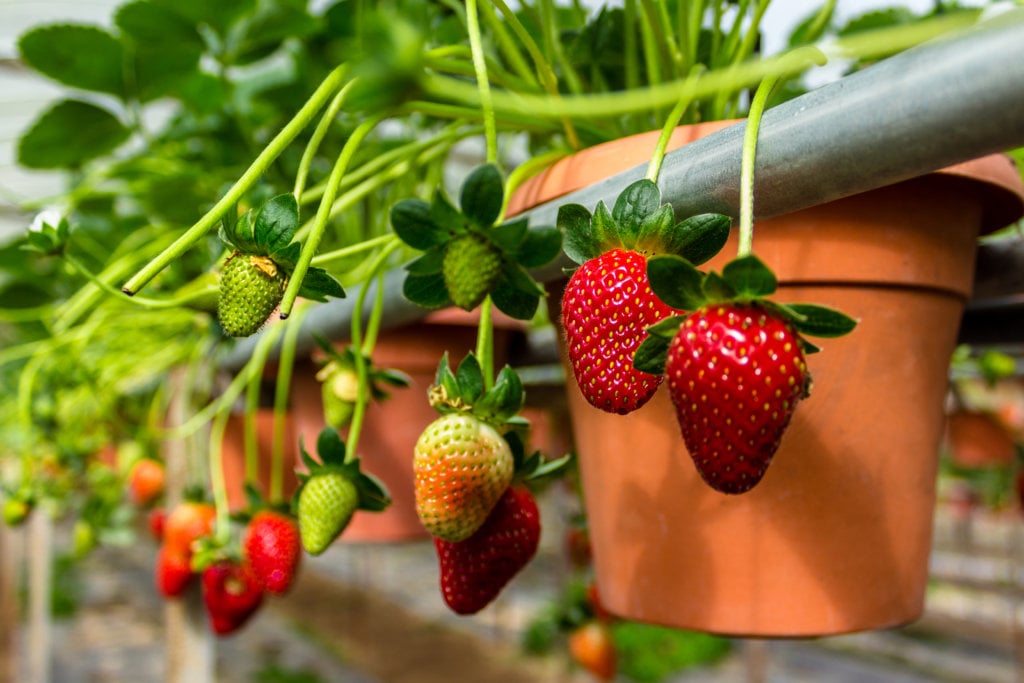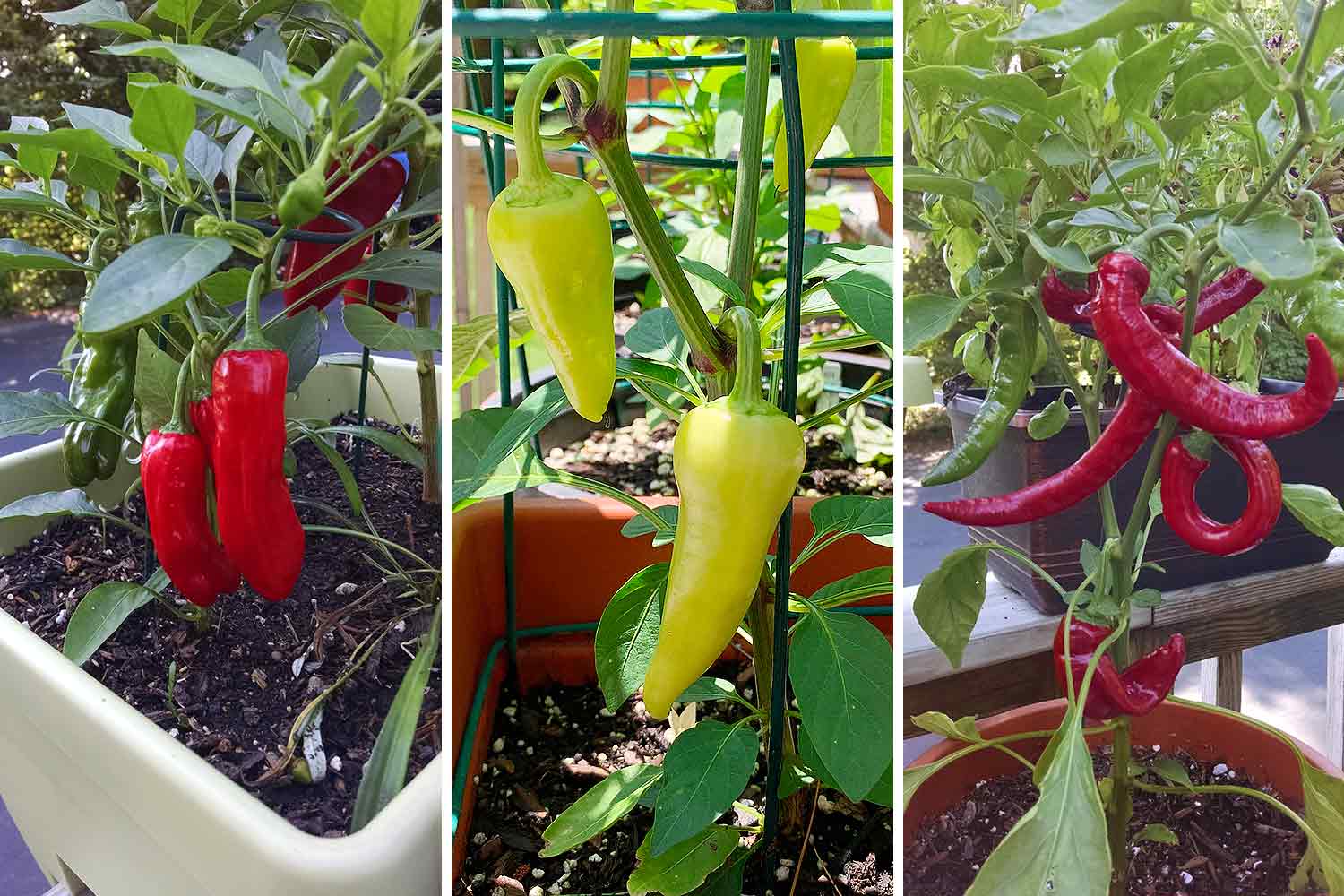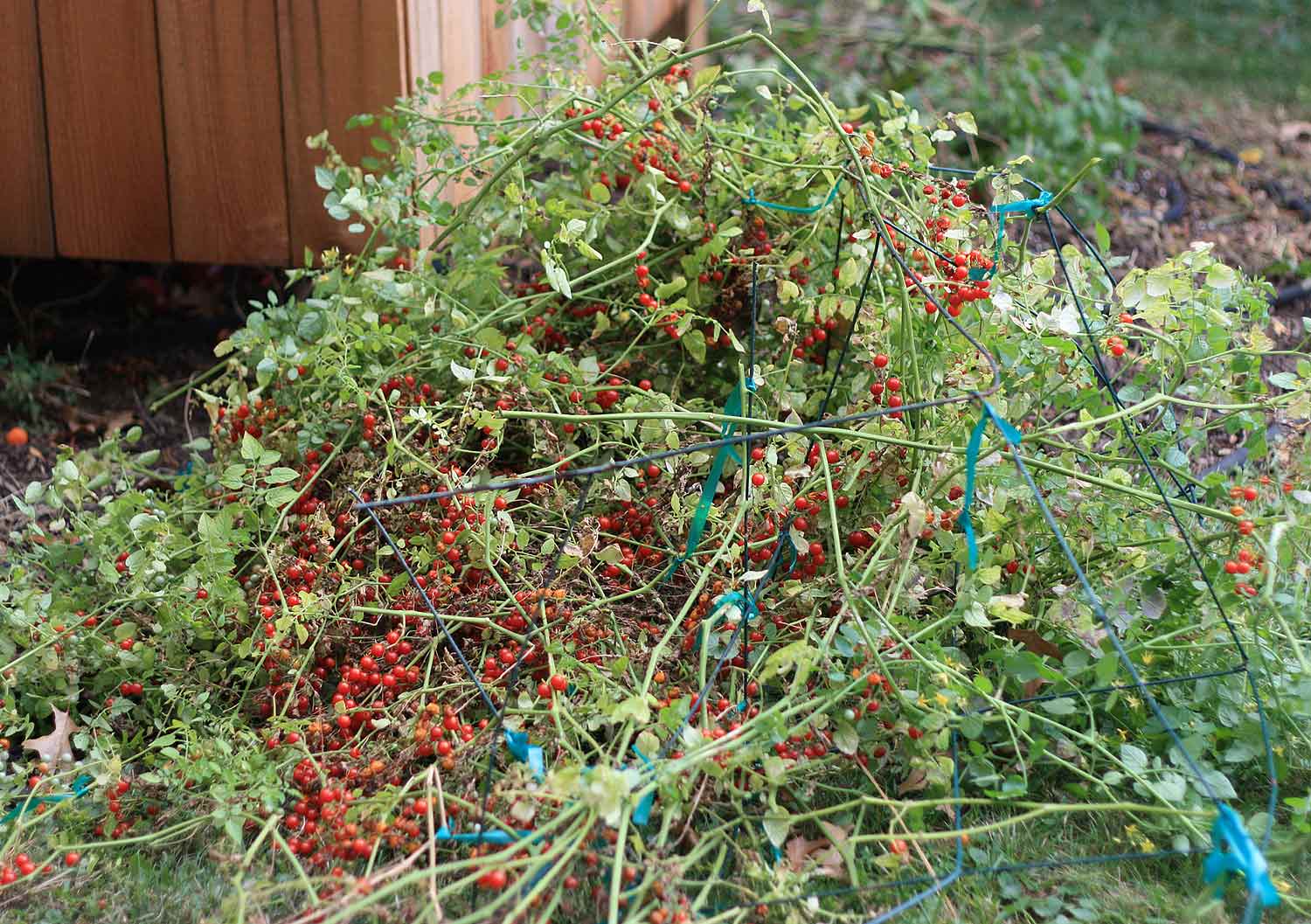Interested in growing your own vegetables, but don’t have access to a plot of land? Or maybe you’re a beginner gardener who isn’t quite ready to take on a full-scale garden. Whatever your situation, vegetable container gardening might be the perfect solution for you! Growing herbs and vegetables in pots allows you to produce your own edibles in a small space, such as a sunny balcony or patio, using containers like pots, buckets, storage tubs, and raised benches.
Not only is container gardening a great way to get your feet wet in vegetable gardening, but it also allows you to enjoy the satisfaction of having fresh, homegrown produce all season long. In this blog post, I’ll cover everything you need to know to get started with herb and vegetable container gardening, from choosing the right containers and soil to selecting the best vegetables for your container garden and caring for your plants throughout the season.
I’ve had container gardens at two residences now. The first was at my apartment in grad school, which had a southeast-facing balcony. Not perfect, but had just enough sun to produce a bountiful harvest of bell peppers and a lone cherry tomato plant.
The second is at my current home. When I first moved here, my backyard had plenty of sunlight near the house for a nice, sizable garden, while the rest of the yard was shaded with trees.
But, around year ten or so, the line of robust pine trees that edge the property began obscuring all of the sunny patches in the yard. After a very dismal tomato harvest one year, I had to acknowledge that backyard gardening was pretty much over, unless I wanted to spend thousands of dollars on complicated tree removal (which I didn’t).
That is, except for my deck. The deck off of my house has full sunlight all day long, with no threat from trees … and plenty of room. So, I moved my garlic, onions, some tomatoes, and the big vining crops — winter squash and sweet potatoes — to space in a nearby community garden, and almost everything else to my deck. I have a few sunny spots that are now the permanent home to my perennial herbs.
Note that garlic, onions, tomatoes, and vining crops absolutely can grow in containers. I just have the good fortune to live right next door to a community garden with spacious plots, and I’m happy to be able to connect with other gardeners every day like that.
This is a long article, so please take advantage of the Table of Contents above and other jumps links throughout to help you get to the information that interests you the most!
Growing your own vegetables is an extremely rewarding hobby Not only does it allow you to learn about gardening, but it also provides you with fresh, organic produce right from your own patio or balcony While having a backyard garden is ideal, you can absolutely grow plenty of vegetables successfully in pots too!
Container gardening opens up opportunities for those with limited yard space. With the right pots, soil, and plants suited to containers, even beginners can cultivate a bountiful harvest on a balcony or porch.
In this article, we’ll explore 15 of the easiest vegetables to grow in pots for beginners. With proper care and conditions, these crops are well-adapted to thriving in containers. Let’s get started!
Why Grow Vegetables in Pots?
There are many benefits to growing vegetables in containers making it a great option for beginners
-
Convenience – Pots can be placed wherever it’s convenient, giving flexibility in site selection. They’re also easy to move as needed.
-
Space efficiency – Perfect for small yards or balconies pots allow you to maximize every square inch. Vertical gardens further boost density.
-
Controlled environment – In pots, you can regulate the soil quality, drainage, sunlight exposure, and other factors critical for plant health.
-
Portability – Rolling pots around lets you protect plants from harsh weather and ensure they get adequate sunlight.
-
Aesthetic appeal – From rustic wooden planters to colorful glazed ceramics, pots add visual interest to any space.
15 Best Vegetables for Beginner Container Gardens
When selecting vegetables for containers, opt for naturally compact, fast-growing varieties that don’t require much root space. Here are 15 great options:
1. Leafy Greens
Leafy greens like lettuce, spinach, kale, and chard are excellent for beginner container gardening. They grow fast, thrive in partial sun, and can be planted in succession for continual harvests. Target mini and looseleaf lettuce varieties.
2. Radishes
Perfect for pots, radishes mature rapidly (in ~30 days) and have shallow roots. Sow every week for a steady supply. Choose quicker cultivars like ‘Cherry Belle’.
3. Green Onions
Another fast-grower, green onions reach harvest size in 50-60 days. Plant densely in a window box. Tip: To get long, blanched stems, hill up soil as they grow.
4. Bush Beans
Pole beans need trellising, but bush types stay compact and yield well in containers. Go for dwarf varieties like ‘Maxibel’.
5. Beets
Beets are great for small spaces. Mini varieties like ‘Baby Ball’ or ‘Little Beet’ are perfect for pots.
6. Carrots
While most carrots get too large for containers, mini types like ‘Little Finger’ and ‘Parisian’ fit the bill at just 3-4″ long.
7. Herbs
Basil, parsley, thyme, oregano, and more thrive in pots near the kitchen. Choose compact varieties with smaller growth habits.
8. Peppers
Bell and chili peppers adapt well to container life. Opt for dwarf, bushy cultivars that won’t outgrow their pots.
9. Eggplant
Eggplants produce surprisingly well in 5+ gallon containers. Seek out container-friendly compact varieties like ‘Little Fingers’.
10. Cucumbers
Bush cucumbers like ‘Pickle’ and ‘Saladmore’ save space by growing vertically on a trellis, rather than sprawling.
11. Cherry Tomatoes
Full-sized tomatoes need very large pots. For beginners, focus on planting cherry or grape tomato varieties which stay more compact.
12. Potatoes
Grow potatoes in a 15-20 gallon container. Add soil as foliage grows until it reaches 1″ below the rim. Hill soil over exposed tubers.
13. Bush Squash
Although vining squash types require ample room, bush varieties like zucchini and summer squash bear well in 1′ deep, 15″ diameter containers.
14. Strawberries
A perfect fruiting plant for hanging containers, strawberries thrive when their delicate fruits don’t touch soil. Let them cascade from baskets.
15. Peas
Sugar snap and snow peas produce vertical vines well-suited for small spaces. Use trellises and mesh to support their growth.
Container Gardening Tips for Beginners
Follow these tips to ensure success with your first container vegetable garden:
-
Sunlight: Place containers where plants will get 6+ hours of direct sun, adjusting as needed.
-
Soil: Use quality potting mix, not garden soil. Add compost for nutrients.
-
Drainage: Ensure containers have holes so water can drain fully. Elevate pots to prevent puddling.
-
Water: Check soil daily, watering when top 1” is dry. Don’t oversaturate.
-
Fertilizer: Apply organic granular fertilizer per label instructions 2-4 weeks after planting.
-
Support: Insert stakes or trellises for vegetables that vine or get tall and leggy.
-
Maintenance: Weed and prune regularly. Remove spent plants promptly.
-
Harvesting: Pick ripe vegetables frequently to encourage more production.
The Rewards of Growing Your Own Food
One of the best parts of container gardening is getting to enjoy fresh, homegrown produce. There’s nothing quite like biting into a juicy, ripe tomato or pepper you grew on your own patio! Gardening also provides stress relief, keeps you active outdoors, and saves money at the grocery store.
With some planning, the right containers and soil, and proper plant care, beginners can absolutely succeed at container vegetable gardening. Try starting with 2-3 of the easy crops listed here to get your first delicious harvest. The satisfaction you’ll gain from nurturing your plants from seed to table is invaluable. Let your container garden be a source of joy, learning, and bountiful vegetables this season!

What is a good soil mix for container gardening?
This is one of the few disadvantages of container gardening, I have to say. Many, many years ago, commercial soil mixes were actually pretty decent, and you could buy bags from the local garden center with complete confidence that your plants would be in good hands.
But time and capitalism have not been kind. The potting soil mixes available today leave very much to be desired. Occasionally, I might find a brand with a beautiful mixture, and breathe a new loyal customer’s sigh of relief, only to discover the following year that they’ve succumbed to … whatever pressures cause them to willingly sink their quality into oblivion.
I could go on and on about this topic, but I’ll cut right to the chase. Here’s the DIY soil mix that I use in all of my vegetable pots:
1 part potting soil 1 part compost 1 part peat moss 1 part perlite Handful of Plant-tone
By “part” I simply mean some volume of measure. It doesn’t matter what it is and it doesn’t have to be precise, because you need to fill your pots with soil, whatever the final amount is.
Use a food storage container or a large, handled mixing bowl from the kitchen or an extra large scoop as the “part” and measure out each component with that tool into a large bucket or storage tub. Mix well, and then scoop into your pots.
All of these components, including compost, can be found at your local garden center or home improvement store. Potting soil and compost are most economically purchased in large, awkward bags. Potting soil and peat moss can be found in large, medium, or small bags. Perlite and Plant-tone are usually packaged in smaller bags and might be shelved elsewhere, with the fertilizers.
Herbs are less fussy, and I usually use mostly potting soil with some peat moss and perlite worked in.
What about moisture control potting soils? I’m conflicted about these products. They do work well for container gardening, as one of the biggest challenges to growing healthy plants is keeping up with water requirements. Vegetables in containers are thirsty, and moisture control soils do retain water quite well.
My objection is that the companies that produce moisture control soils also add fertilizers that I personally do not use, because I maintain fully organic gardens.
However, if you’re new to vegetable gardening, and are not concerned about organic products, a moisture control soil is not the worst choice you can make.

Efficient Use of Space
Container gardening is ideal for those with limited outdoor space, such as urban dwellers, apartment residents, or homeowners with small, shady yards, or land with poor soil.
By taking advantage of open space on a sunny balcony, patio, or deck, you can still enjoy an abundant harvest of herbs and vegetables. I’ll put containers anywhere: on an outdoor windowsill, in a hanging basket, on the deck or porch rail.
Some years ago, my brother built me this beautiful raised garden bench, where I plant lettuce greens and annual herbs. It’s absolutely my favorite gardening thing in the whole world.

Side story: One season, a Black Swallowtail butterfly laid eggs all over my dill and parsley plants on that bench, and I was treated to this amazing spectacle:

Yes, of course, butterflies lay their eggs in gardens all the time, but these caterpillars would not have survived out in the bird-heavy environs of the yard. They were protected from predators by the shade screen I keep draped over this bench.
So, yes, I give all credit to container gardening for that gift during a pandemic when we needed all the beauty we could get!
Planting your herbs and vegetables in containers allows you to control their environment to a greater degree than plants in the ground.
Some plants, such as celery, benefit from partial shade during the day, and I can reposition the pots as needed. Others, such as tomatoes, need full sun at all times. During heavy periods of rain, it’s easier to protect vegetables in pots from becoming waterlogged for days.
And of course, preventing damage during severe storms is much easier with container gardens. I’m very far inland in the U.S., but in 2008 the remnants of Hurricane Ike blew through, knocking out power to the county for 5 days straight days, and heartbreakingly decimated a few of my September-tall tomato plants.

There was no way to sufficiently stabilize this plant against wind shear out in the yard, but in a container on my deck, I would’ve had several options. (I was lucky: being a home gardener meant I just lost a few plants. Some corn and tomato farms nearby lost their entire crops — and revenue — for the last half of the season.)
Top 7 Container Veggies For Beginners – Garden Quickie Episode 142
FAQ
What is the quickest vegetable to grow?
Radishes are one of the fastest crops you can grow—it takes the vegetable about six weeks to grow from seed to harvest. On Martha’s farm in New York, April is the standard month to plant radishes, as they can handle cold but not heavy frost.
What is the easiest vegetable garden for beginners?
- lettuces
- tomato plants are kind of hit or miss for some beginners
- other leafy greens like kale & Swiss chard
- root vegetables like carrots, radishes, turnips
- strawberries
- cucumbers
- peas
What vegetable is best to grow in pots?
- We recommend: ‘Tumbling Tom Red’ Tomato Plants and Organic ‘Tiny Tim’ Tomato Plants.
- We recommend: ‘New Ace’ Red Sweet Pepper Plants and ‘Yellow Bell’ Sweet Pepper Plants.
- We recommend: ‘Perpetual’ Spinach Plants and ‘Reflex F1’ Curly Kale Plants.
What is a good first vegetable to grow?
Potatoes are a good beginner crop because they’re easy to sow, quick to grow, and fun to dig out. You can start with seeds, but it’s easier to opt for “seed potatoes,” which are pieces of a potato or whole small ones.
